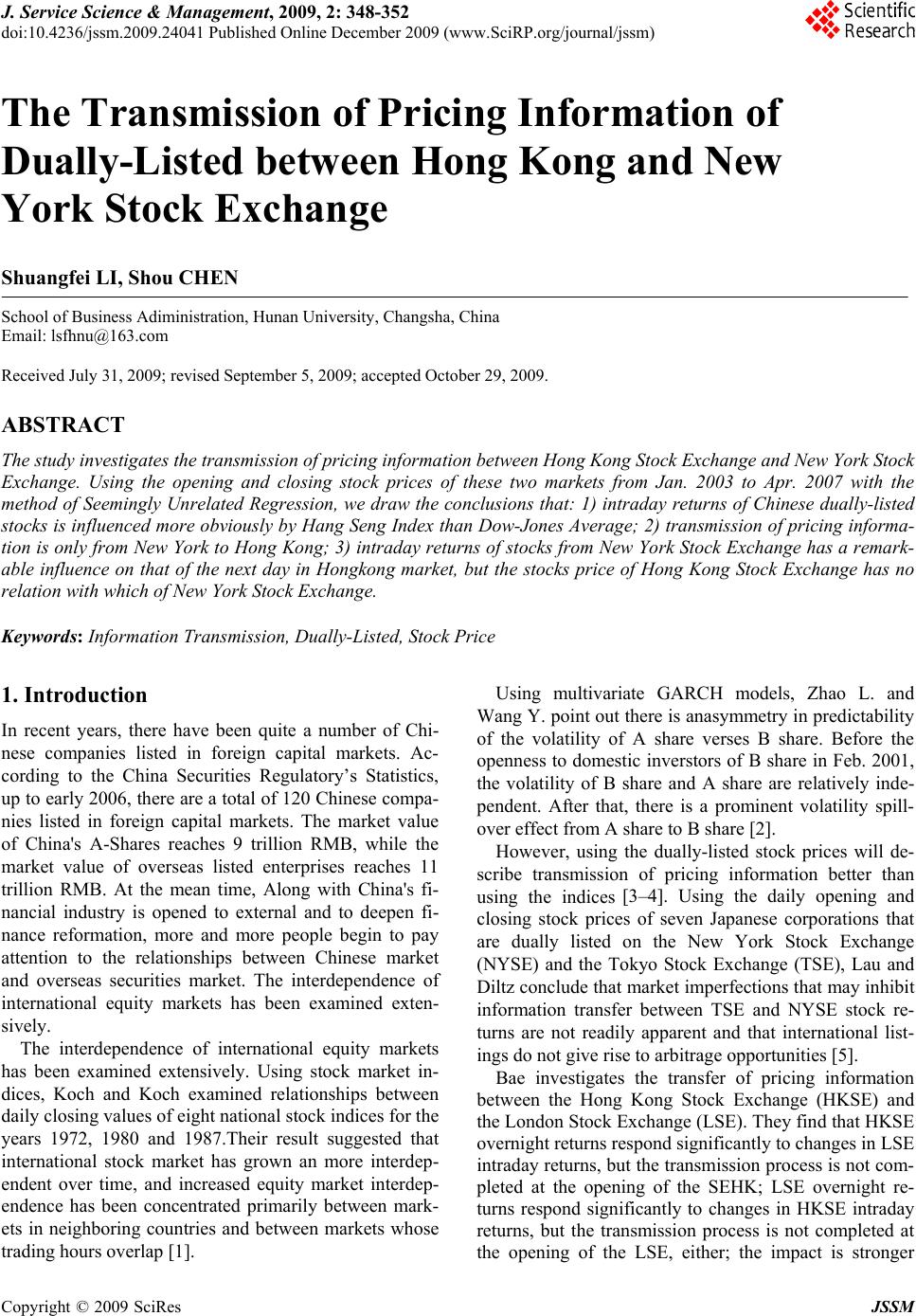
J. Service Science & Management, 2009, 2: 348-352
doi:10.4236/jssm.2009.24041 Published Online December 2009 (www.SciRP.org/journal/jssm)
Copyright © 2009 SciRes JSSM
The Transmission of Pricing Information of
Dually-Listed between Hong Kong and New
York Stock Exchange
Shuangfei LI, Shou CHEN
School of Business Adiministration, Hunan University, Changsha, China
Email: lsfhnu@163.com
Received July 31, 2009; revised September 5, 2009; accepted October 29, 2009.
ABSTRACT
The study investigates the transmission of pricing information between Hong Kong Stock Exchange and New York Stock
Exchange. Using the opening and closing stock prices of these two markets from Jan. 2003 to Apr. 2007 with the
method of Seemingly Unrelated Regression, we draw the conclusions that: 1) intraday returns of Chinese dually-listed
stocks is influenced more obviously by Hang Seng Index than Dow-Jones Average; 2) transmission of pricing informa-
tion is only from New York to Hong Kong; 3) intraday returns of stocks from New York Stock Exchange has a remark-
able influence on that of the next day in Hongkong market, but the stocks price of Hong Kong Stock Exchange has no
relation with which of New York Stock Exchange.
Keywords: Information Tra n smi ssi o n, D ually-List ed, St o ck Price
1. Introduction
In recent years, there have been quite a number of Chi-
nese companies listed in foreign capital markets. Ac-
cording to the China Securities Regulatory’s Statistics,
up to early 2006, there are a total of 120 Chinese compa-
nies listed in foreign capital markets. The market value
of China's A-Shares reaches 9 trillion RMB, while the
market value of overseas listed enterprises reaches 11
trillion RMB. At the mean time, Along with China's fi-
nancial industry is opened to external and to deepen fi-
nance reformation, more and more people begin to pay
attention to the relationships between Chinese market
and overseas securities market. The interdependence of
international equity markets has been examined exten-
sively.
The interdependence of international equity markets
has been examined extensively. Using stock market in-
dices, Koch and Koch examined relationships between
daily closing values of eight national stock indices for the
years 1972, 1980 and 1987.Their result suggested that
international stock market has grown an more interdep-
endent over time, and increased equity market interdep-
endence has been concentrated primarily between mark-
ets in neighboring countries and between markets whose
trading hours overlap [1].
Using multivariate GARCH models, Zhao L. and
Wang Y. point out there is anasymmetry in pred ictability
of the volatility of A share verses B share. Before the
openness to domestic inverstors of B share in Feb. 2001,
the volatility of B share and A share are relatively inde-
pendent. After that, there is a prominent volatility spill-
over effect from A share to B share [2].
However, using the dually-listed stock prices will de-
scribe transmission of pricing information better than
using the indices [3–4]. Using the daily opening and
closing stock prices of seven Japanese corporations that
are dually listed on the New York Stock Exchange
(NYSE) and the Tokyo Stock Exchange (TSE), Lau and
Diltz conclude that market imperfections th at may inhibit
information transfer between TSE and NYSE stock re-
turns are not readily apparent and that international list-
ings do not give rise to arbitrage opportun ities [5].
Bae investigates the transfer of pricing information
between the Hong Kong Stock Exchange (HKSE) and
the London Stock Exchang e (LSE). They find that HKSE
overnight returns respond significantly to changes in LSE
intraday returns, but the transmission pro cess is not com-
pleted at the opening of the SEHK; LSE overnight re-
turns respond significantly to changes in HKSE intraday
returns, but the transmission process is not completed at
the opening of the LSE, either; the impact is stronger